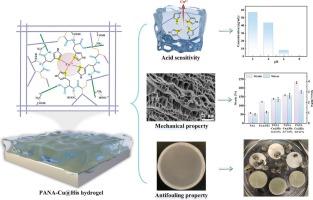基于动态金属-配体相互作用的刺激响应复合涂层可持续海洋防污
IF 9.2
2区 工程技术
Q1 ENERGY & FUELS
引用次数: 0
摘要
虽然铜基防污剂是防止海洋生物污染的有效解决方案,但其利用效率仍然是一个关键挑战。本研究通过聚丙烯酸网络与组氨酸配位铜纳米团簇的协同整合,展示了一种ph响应水凝胶复合材料。通过密度泛功能理论(DFT)模拟,确定组氨酸和Cu2+的主要配体构型为“咪唑为主、羧基辅助”,为水凝胶的pH敏感性提供了理论支持。这种涂层可以根据外界pH值的变化精确地“按需”释放Cu2+,有效地防止藻类和污垢生物的粘附,并对铜绿假单胞菌和大肠杆菌具有很高的杀菌率。该涂层独特的分子设计结合了多个酰胺基元,通过强氢键自组装成蜂窝网络,而Cu2+和组氨酸之间的配位建立了动态的金属-配体相互作用,具有可调节的解离动力学和内聚强度。这种智能控释复合水凝胶通过精确有效地释放防污剂,显著降低了海洋污染的风险,为建立可持续的海洋防污系统提供了一种创新的解决方案。本文章由计算机程序翻译,如有差异,请以英文原文为准。

Stimuli-responsive composite coating based on dynamic metal-ligand interactions for sustainable marine antifouling
While copper-based antifoulants represent effective solutions for marine biofouling prevention, their utilization efficiency remains a critical challenge. This investigation demonstrates a pH-responsive hydrogel composite through synergistic integration of poly(acrylic acid) networks with histidine-coordinated cupric nanoclusters. The main ligand configuration of histidine and Cu2+ was identified as “imidazole-dominated and carboxyl-assisted” by density functional theory (DFT) simulation, which provides theoretical support for the pH sensitivity of hydrogel. This coating releases Cu2+ precisely “on demand” in response to external pH changes, effectively preventing algae and fouling organisms from adhering and achieving high bactericidal rates against Pseudomonas aeruginosa and E. coli. The distinctive molecular design of the coating combines multiple amide motifs that self-assemble into a honeycomb network via strong hydrogen bonding, while the coordination between Cu2+ and histidine establishes a dynamic metal-ligand interaction with tunable dissociation kinetics and cohesion strength. This intelligent controlled-release composite hydrogel significantly reduces the risk of marine fouling by releasing antifouling agents precisely and efficiently, providing an innovative solution for building a sustainable marine antifouling system.
求助全文
通过发布文献求助,成功后即可免费获取论文全文。
去求助
来源期刊

Sustainable Materials and Technologies
Energy-Renewable Energy, Sustainability and the Environment
CiteScore
13.40
自引率
4.20%
发文量
158
审稿时长
45 days
期刊介绍:
Sustainable Materials and Technologies (SM&T), an international, cross-disciplinary, fully open access journal published by Elsevier, focuses on original full-length research articles and reviews. It covers applied or fundamental science of nano-, micro-, meso-, and macro-scale aspects of materials and technologies for sustainable development. SM&T gives special attention to contributions that bridge the knowledge gap between materials and system designs.
 求助内容:
求助内容: 应助结果提醒方式:
应助结果提醒方式:


